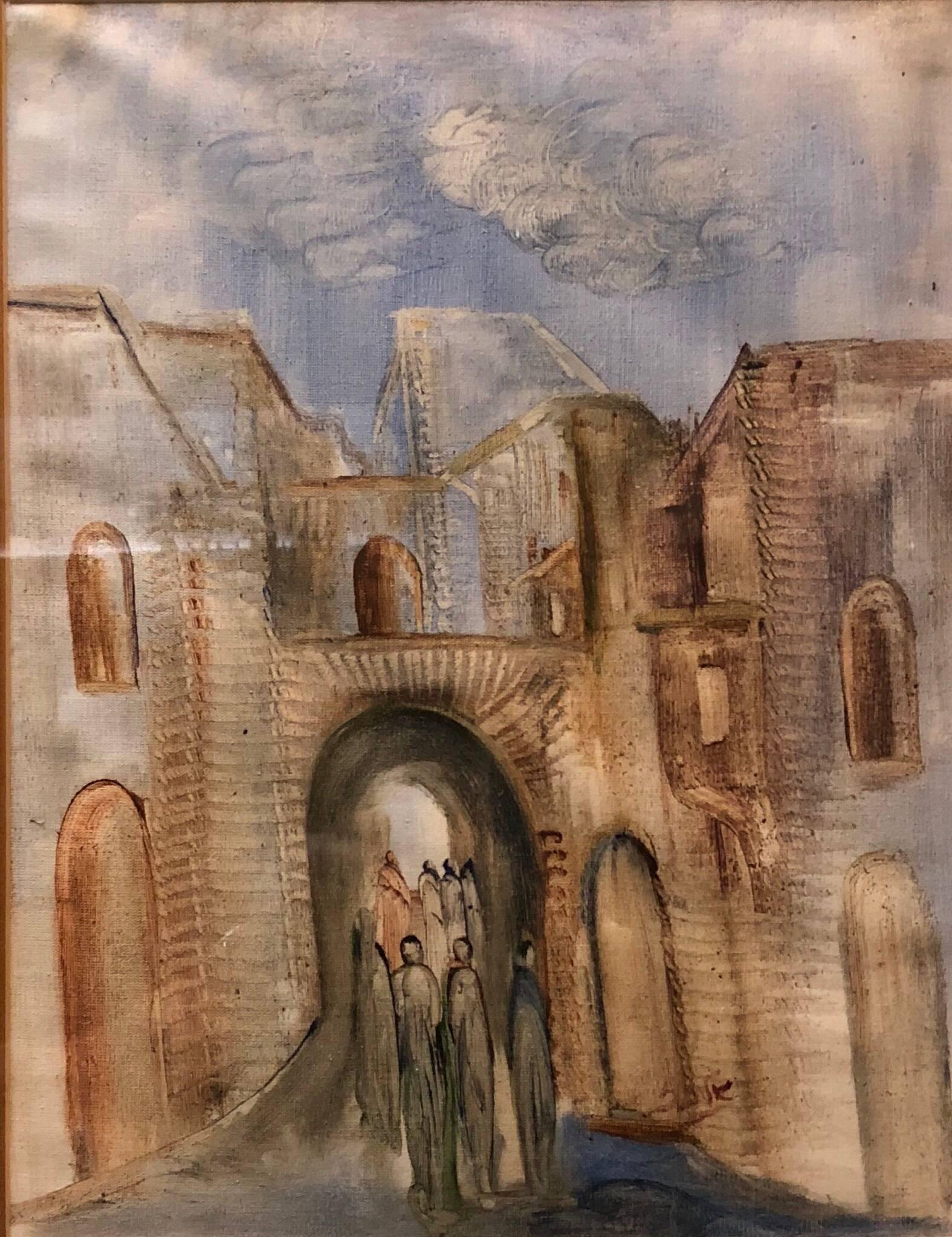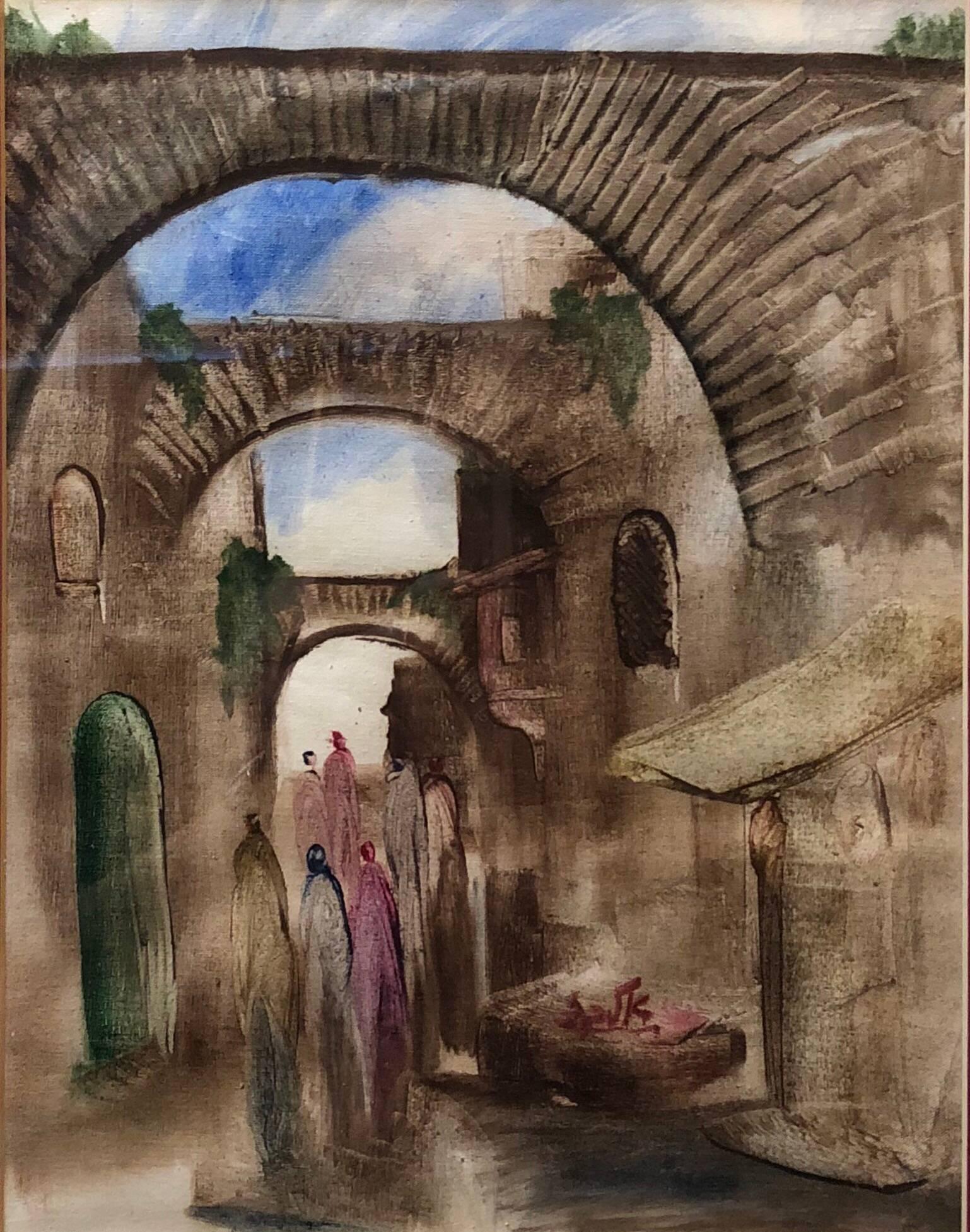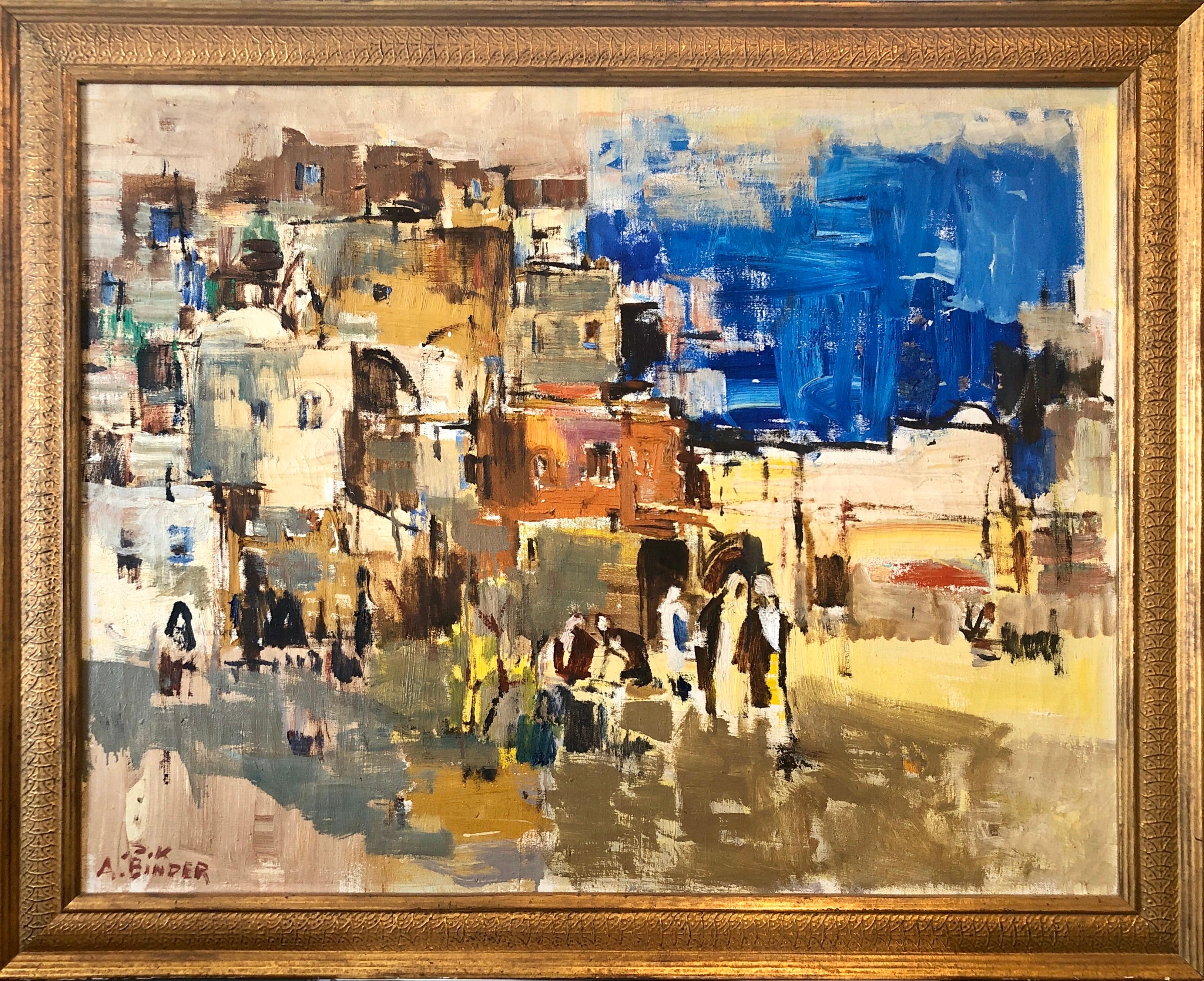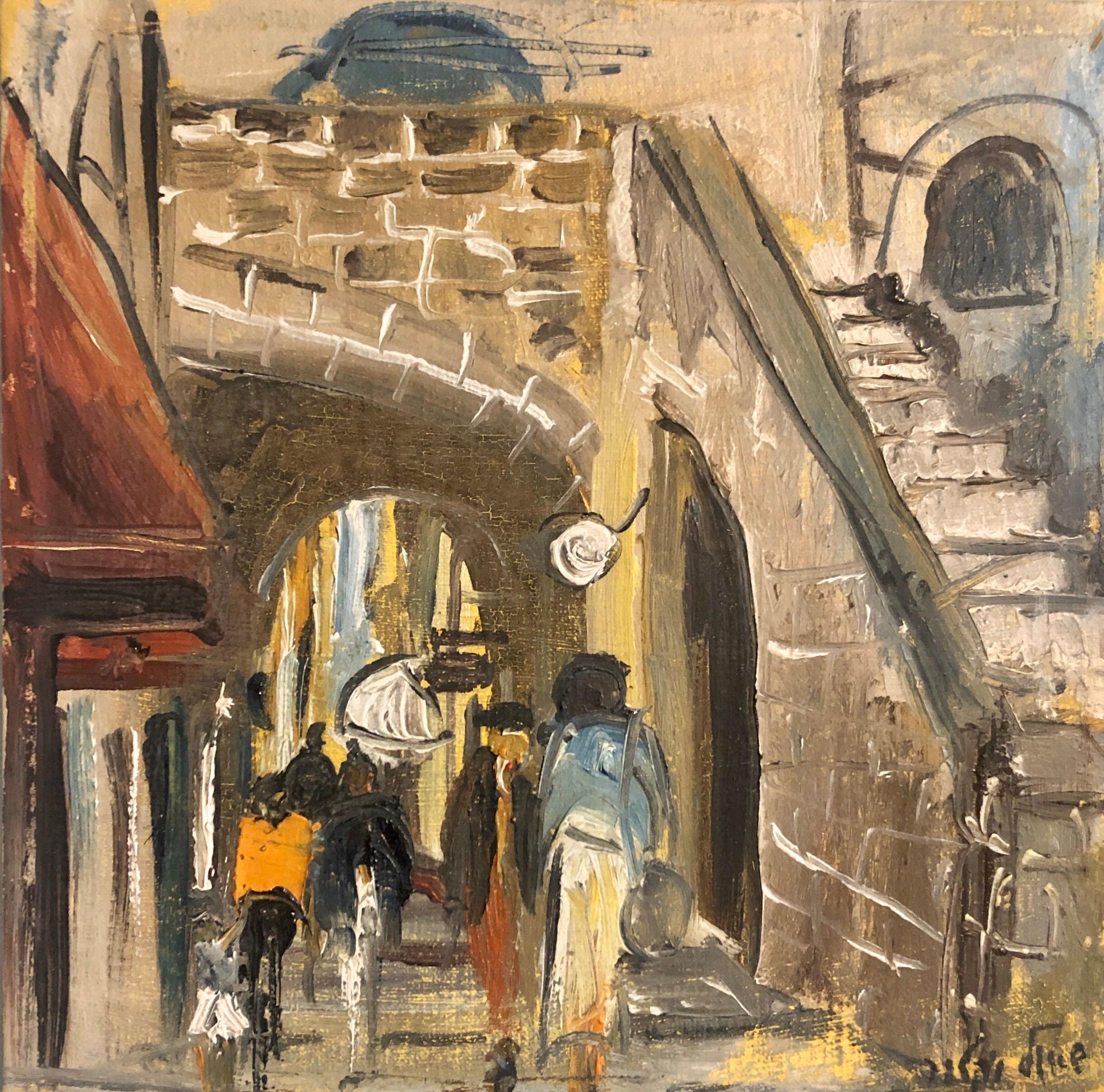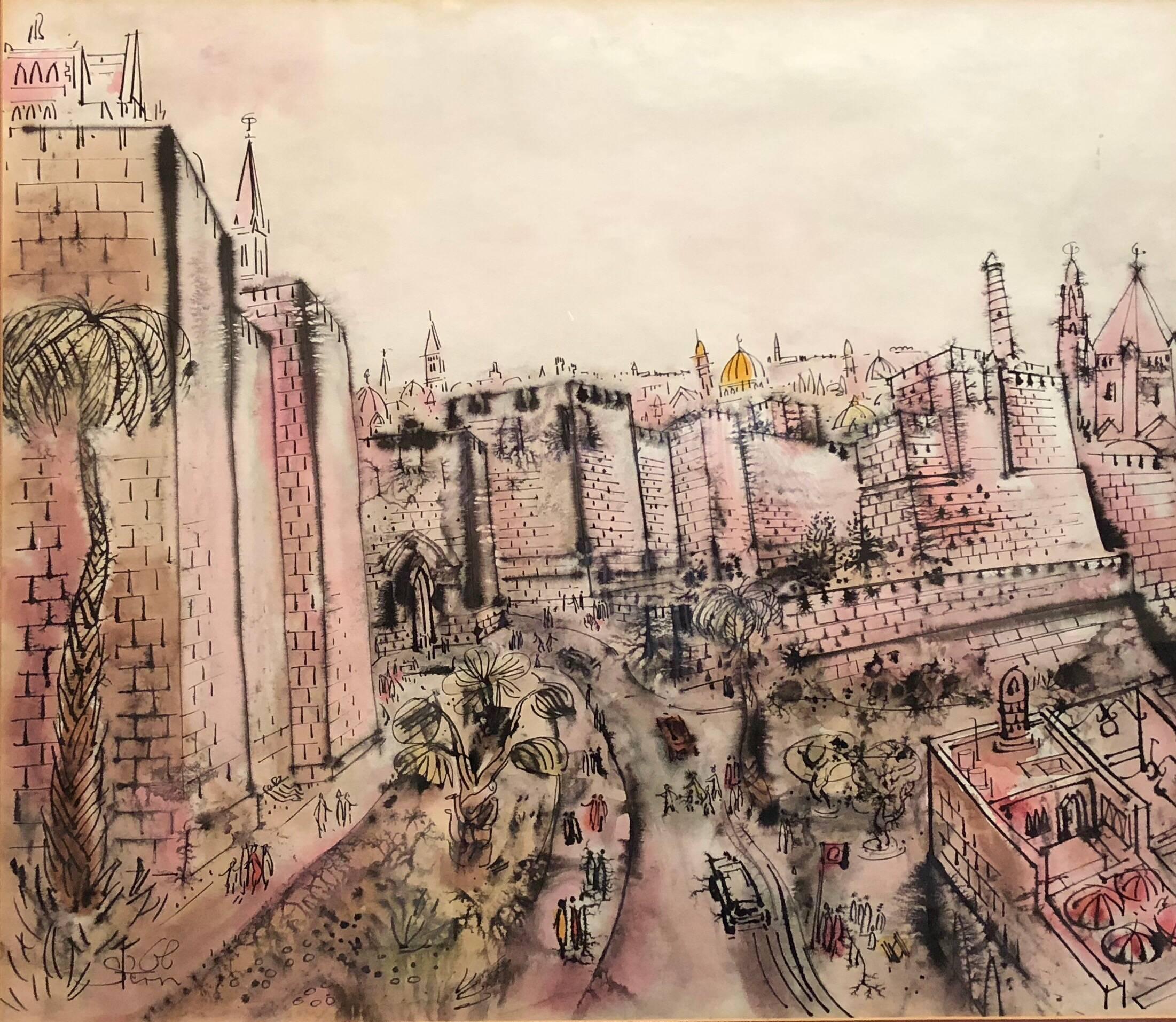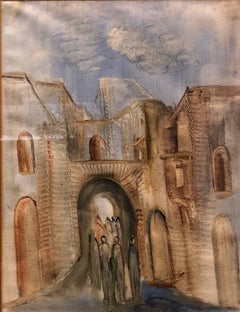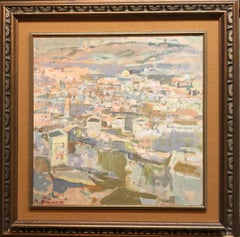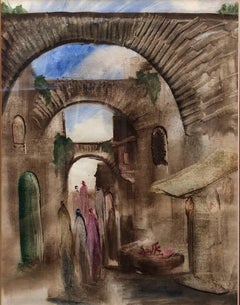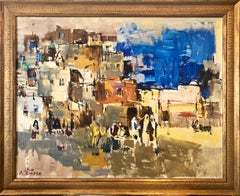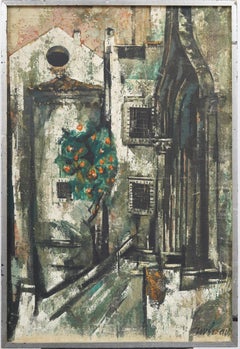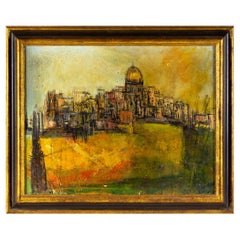Items Similar to Jerusalem Old City Cityscape Israeli Modernist Oil Painting Signed in Hebrew
Want more images or videos?
Request additional images or videos from the seller
1 of 11
UnknownJerusalem Old City Cityscape Israeli Modernist Oil Painting Signed in Hebrewc.1950s
c.1950s
$2,200
£1,669.31
€1,908.71
CA$3,072.80
A$3,416.54
CHF 1,783.93
MX$41,587.60
NOK 22,762.15
SEK 21,327.05
DKK 14,245.02
Shipping
Retrieving quote...The 1stDibs Promise:
Authenticity Guarantee,
Money-Back Guarantee,
24-Hour Cancellation
About the Item
Signed Nathanson. Could be the famous artist Avraham Naton (Natanson) I am not certain. it is a very lovely Modernist Israeli landscape.
Avraham Naton (Natanson), Israeli, born in Bessarabia, 1906-1959. Avraham Naton was born in Rani, Bessarabia to a large secular family. In 1935, after Art studies in Romania, he immigrated to the Land of Israel and settled, first, in Givat Haim and later in Ramat Gan. From the 1940s he worked as an Art teacher in Ramat Gan and Givataim. In 1948 he worked as an illustrator at BaMahane Newspaper. He was one of the Founders of New Horizon Group. Between 1952-1959 he was a member of the Milo Club and served as the club secretary.
Education
1930-33 Art Academy, Bucharest, Romania
Teaching
1940's Ramat Gan and Givataim
Awards And Prizes
Jerusalem Prize for Painting and Sculpture
1942 Dizengoff Prize
1953 Milo Club Prize
New Horizons, The Ofakim Hadashim art movement began with a group of artists who mounted an exhibition in Tel Aviv's Habima national theater in December 1942, under the name "The Group of Eight". The group evolved into a coherent artistic movement only after the founding of the state of Israel in 1948. Members of the school included Arie Aroch, Zvi Meirovitch, Avraham Naton (Natanson), Avigdor Stematsky and Yehezkel Streichman. The work of sculptor Dov Feigin also appeared in the catalog of the 1942 exhibition, though it was not displayed. In February 1947 five of the original members of the group joined Joseph Zaritsky for an exhibit called "The Group of Seven" at the Tel Aviv Museum of Art. Marcel Janco,Shmuel Raayoni, Aharon Kahana, Yohanan Simon, Avshalom Okashi, Moshe Castel were all members. Members of the group stated that "The group is based in modernism, especially French, yet seeks a unique style that expresses our own reality"
About the Seller
4.9
Platinum Seller
Premium sellers with a 4.7+ rating and 24-hour response times
Established in 1995
1stDibs seller since 2014
1,784 sales on 1stDibs
Typical response time: <1 hour
- ShippingRetrieving quote...Shipping from: Surfside, FL
- Return Policy
Authenticity Guarantee
In the unlikely event there’s an issue with an item’s authenticity, contact us within 1 year for a full refund. DetailsMoney-Back Guarantee
If your item is not as described, is damaged in transit, or does not arrive, contact us within 7 days for a full refund. Details24-Hour Cancellation
You have a 24-hour grace period in which to reconsider your purchase, with no questions asked.Vetted Professional Sellers
Our world-class sellers must adhere to strict standards for service and quality, maintaining the integrity of our listings.Price-Match Guarantee
If you find that a seller listed the same item for a lower price elsewhere, we’ll match it.Trusted Global Delivery
Our best-in-class carrier network provides specialized shipping options worldwide, including custom delivery.More From This Seller
View AllJerusalem Old City Landscape, Expressionist Judaica Israeli Painting II
By Andre Elbaz
Located in Surfside, FL
In this painting the artist uses gestural brushstrokes, which causes distortion and exaggeration for emotional effect. Andre Elbaz uses as his subject figures walking in old city Jerusalem.
André Elbaz (born April 26, 1934, El Jadida, Morocco) is a famous Moroccan painter and filmmaker.
Elbaz studied art and theatre in Rabat and Paris from 1950 to 1961. He started painting only at the age of 21, until which age he had been interested mainly in theatre. A few years later, he managed to combine his two passions into a new approach in art-therapy, inventing together with his wife, a psychiatrist, the Pictodrame, which brought him world recognition.
His first exhibition, which was very successful, took place in Casablanca in 1961 and earned him an appointment as Professor at the Beaux-Arts school in Casablanca. Years later, in 1976, he exhibited his paintings at the Tel-Aviv Museum.
In parallel to his career as a painter, Elbaz is also known as a filmmaker. He produced several short films in France, Canada and the United States. One of them, La nuit n'est jamais complète (The night is never complete), won a prize at the "5th Biennale de Paris in 1967". Among the themes chosen for the many films he produced, there was a short one about the Warsaw Ghetto uprising, as well as a series of drawings entitled Seuls (Alone), with texts written by both Elie Wiesel...
Category
20th Century Expressionist Figurative Paintings
Materials
Paper, Gouache
Large Abstract landscape of Jerusalem Israeli Oil Painting Judaica
By Avraham Binder
Located in Surfside, FL
Avraham Binder was born in 1906 in Vilnius (or Vilna), now part of Lithuania. He began painting at an early age and completed the prescribed studies in painting at the academy of art...
Category
20th Century Modern Landscape Paintings
Materials
Canvas, Oil
Jerusalem Old City Landscape, Expressionist Judaica Israeli Painting
By Andre Elbaz
Located in Surfside, FL
In this painting the artist uses gestural brushstrokes, which causes distortion and exaggeration for emotional effect. Andre Elbaz uses as his subject figures walking in old city Jerusalem.
André Elbaz (born April 26, 1934, El Jadida, Morocco) is a famous Moroccan painter and filmmaker.
Elbaz studied art and theatre in Rabat and Paris from 1950 to 1961. He started painting only at the age of 21, until which age he had been interested mainly in theatre. A few years later, he managed to combine his two passions into a new approach in art-therapy, inventing together with his wife, a psychiatrist, the Pictodrame, which brought him world recognition.
His first exhibition, which was very successful, took place in Casablanca in 1961 and earned him an appointment as Professor at the Beaux-Arts school in Casablanca. Years later, in 1976, he exhibited his paintings at the Tel-Aviv Museum.
In parallel to his career as a painter, Elbaz is also known as a filmmaker. He produced several short films in France, Canada and the United States. One of them, La nuit n'est jamais complète (The night is never complete), won a prize at the "5th Biennale de Paris in 1967". Among the themes chosen for the many films he produced, there was a short one about the Warsaw Ghetto uprising, as well as a series of drawings entitled Seuls (Alone), with texts written by both Elie Wiesel...
Category
20th Century Expressionist Figurative Paintings
Materials
Paper, Gouache
Large Abstract landscape of Jerusalem Israeli Oil Painting Judaica
By Avraham Binder
Located in Surfside, FL
Large gilt framed abstract modernist landscape of Jerusalem. Framed it measures 33.25 X 41.25 inches. Canvas measures 28 x 36 inches. Bold Blue sky.
Avraham Binder was born in 1906 in Vilnius (or Vilna), now part of Lithuania. He began painting at an early age and completed the prescribed studies in painting at the academy of arts in his native city. Upon graduation, at the commencement exhibition of works submitted by the graduates, he was awarded a prize in recognition of his talents.
Artistic talent had deep roots in the Binder family. Avraham's father and grandfather were both artistically inclined, as was his sister Zila Binder and daughter Yael. In fact, he came from a long line of master artistic bookbinders, hence the family surname. The Binder family emigrated to Palestine in 1920. There, his father established a bookbinding workshop in Tel-Aviv while Avraham pursued painting. Binder has not identified with any particular modern school nor narrow artistic doctrine. He struggles to verbally explain his personal conception. Instead, he derives inspiration from emotions, resulting in a great variety of artistic treatments.
Particularly memorable are his urban landscapes with their predominance of blues and aquamarines, composed of a profusion of squares and rectangles, crowding one another and covering nearly the entire canvas. The angular shapes are interspersed with radiant dots of red, gold and yellow, like the lights of the big city. Those squares and rectangles reflect, perhaps, impressions of a childhood spent among books which were scattered about the home and workshop of his father, the bookbinder. These shapes, no doubt, had their influence upon the artist whose first youthful impressions were – books.
Traces of these shapes are discernible in Binder’s work to this day, in the angularity of splashes of color which, no longer crowded together, are now well separated to create an airy spaciousness. Not only the splashes of color – the inventing space, too – creates figurative effects in the artist’s treatment.
Avraham Binder is not a “cerebral” painter. Neither identified with any particular modern school, nor preaching any narrow artistic doctrine, he is an emotional artist: his inspiration, derived from the heart, leads him on to the most varied range of treatments in his artistic work. In vain might one try to persuade him to define his personal conception of painting. He is not one to indulge in verbal explanation. But his sheer artistic skill, his virtuosity with the paint brush, did impel him to experiment widely with the artistic techniques of the modern age. And his exceptional talent stood him in good stead in all this experimentation.
Binders large-scale urban landscapes are not mere constructs to represent our present-day architecture with its pervasive angularity. Made up as they are of color, Binder’s unique color composition qualifies these canvases to be ranked among the foremost artistic works in Israeli painting. They are uniquely Binder, very different from what we see in the work of his contemporaries.
Here and there, Binder also introduces the human element into these paintings. He lives and breathes the atmosphere of his surroundings, deeply experiencing the sea and the shore of Tel-Aviv that confront him day after day, and which he has transferred to his canvases, as metaphors in paint, throughout the life. More recently, he has created a new series of shore-and-seascapes, in tones ranging from brown to blue. ochre, violet and pale yellow – marvelous views of the sea and of figures enlivening its shore. In yet another series, featuring nearly the same range of hues, he lets us view, through his eyes, the Carmel Market in Tel-Aviv, or the city’s coffee houses with their crowds of people, heads bunched together as if in search of human closeness, with the windows looking in upon them. He has also done large paintings of Jerusalem – not the Jerusalem of gloom and holiness, but a Jerusalem in contrast to the flat topography of Tel-Aviv; it is this different topography which here provides the challenge for him as a painter. And the colors – the colors are bright, full of light, an inner illumination which seems to emanate from the artist himself, rather than from the sun beating down from above.
So many great artists have built their life’s work upon watercolors. Binder’s watercolors are in no way inferior in their artistic worth to many of those, what with their spontaneity, their translucent quality, their color combinations, and the artist’s ability to say so much with an economy of brush strokes.
We have here a painter who, until the end of his life, was still in his full creative powers, and who continued to add to his impressive storehouse of artistic works. Hundreds of his paintings grace the homes of collectors in Israel and throughout the world, or hang in his private collection; they include Israel landscapes and, most importantly, cityscapes; an exquisite series of wild flowers; many portrait paintings; experimental wood sculptures; murals painted on wood panels; reliefs…, etc. All these are testimony to an artist who refuses to rest on his laurels, who forever reaches out to try his hand at new challenges, strikes out in novel directions, discovers innovative techniques, and experiments in all the dimensions of the plastic arts.
On the Israel Museum website they have listed an exhibition of his
Artists in Israel for the Defense, Tel Aviv Museum of Art, Helena Rubinstein Pavilion, Tel Aviv 1967
Artists: Avraham Binder, Motke Blum, (Mordechai) Samuel Bak, Yosl Bergner, Nahum Gilboa, Jean David, Marcel Janco, Lea Nikel, Jacob Pins, Esther Peretz Arad, Dani Karavan, Reuven Rubin, Zvi Raphaely, Yossi Stern...
Category
20th Century Modern Landscape Paintings
Materials
Canvas, Oil
Israeli Judaica Oil Painting, Street Scene Jerusalem or Safed
By Shaul Victor
Located in Surfside, FL
Shaul Victor, (1947-2016), Russian American Israeli artist, paints vivid Judaica/Israel scenes and portraits.
Shaul Victor, painter. Born in Russia in 1947, immigrated to Israel in ...
Category
20th Century Impressionist Portrait Paintings
Materials
Canvas, Oil
Old City Jerusalem City Walls landscape Scene Painting, Judaica
By Jossi Stern
Located in Surfside, FL
Vibrant Gouache and watercolor painting by Israeli master JOSSI STERN. on paper mounted to board. 31x34.75, 23.5x27.5 without frame.
Hungary, b. 1923, d. 1992
Jossi (Yossi) Stern, son of David and Katerina, was born in the Bakon Hills of Hungary, in 1923. He was already drawing when at the age of ten he moved with his family from the Bakon Hill region to the considerably more cosmopolitan Budapest.
Recognizing the looming threat of Hitler and the pending Nazi invasion of Hungary, in 1940, at the age of seventeen, the young artist made his way to Palestine aboard the Sakaria, an old ship heavily crowded with 2,300 other refugees. Before reaching the shores of Palestine, then under the British Mandate, the British Navy intercepted the ship and declared Stern and all those aboard illegal immigrants. Stern was sent to a prison camp where he remained incarcerated by the British for six months.
In 1943, having spent a few years doing agricultural work, Stern was encouraged by close friends who recognized his artistic talent to enroll in the prestigious Bezalel School of the Arts in Jerusalem. An outstanding student, he eventually became a highly respected teacher of Graphic Arts at Bezalel.
Stern is recognized in Israel as having been one of the country's premier artists...
Category
20th Century Modern Figurative Paintings
Materials
Watercolor, Gouache, Illustration Board
You May Also Like
View of Jerusalem, Framed Impressionist Landscape Oil Painting
Located in Long Island City, NY
Artist: Unknown XXth Century
Title: View of Jerusalem
Medium: Oil on canvas, signed and titled in Hebrew
Image Size: 19.5 x 26.5 in. (49.53 x 67.31 cm)
Frame Size: 25 x 32 inches
Category
Mid-20th Century Modern Landscape Paintings
Materials
Oil, Canvas
Impressionist Landscape Painting of the Holy City of Jerusalem
By Frank Freed
Located in Houston, TX
Lovely impressionistic painting of the Holy City of Jerusalem by Texas artist Frank Freed.
Dimensions of painting itself: H 18 in. x W 24 in.
Artist Biog...
Category
1960s Impressionist Landscape Paintings
Materials
Acrylic
Antique French Modernist Paris School Signed Street Scene Framed Oil Painting
Located in Buffalo, NY
Antique French modernist Paris school cityscape street scene oil painting. Oil on canvas. Framed. Signed. Measuring 27 by 40 inches overall and 26 by 39 painting alone. In excellent...
Category
1940s Modern Abstract Paintings
Materials
Oil, Board
$1,020 Sale Price
20% Off
Mid Century Modern Cityscape Oil Painting On Canvas
Located in Countryside, IL
Mid-Century Modern cityscape oil painting on canvas
This piece measures: 33.75 wide x 1.75 deep x 27.75 inches high
This Painting is in e...
Category
Vintage 1970s American Mid-Century Modern Paintings
Materials
Canvas, Paint
Jerusalem wall urban landscape original oil on canvas painting
By Manuel Capdevila Massana
Located in Barcelona, Barcelona
Unframed
Manuel Capdevila i Massana (Barcelona, December 28, 1910 - April 18, 2006) was a Catalan painter and goldsmith, son of the goldsmith Joaquín Capdevila y Meya and father of the also goldsmith, Joaquim Capdevila y Gaya.
In 1950 he was invited to The 1950 Pittsburgh International contest at the Carnegie Institute, Pennsylvania, where he presented the painting The Priest, which is currently part of the MNAC collection. A year later the Museum of Modern Art in Panama acquired the work Crisantemos.
He was part of the Morera Prize Jury in 1953. Two years later he signed the manifesto that Alexandre Cirici drafted, creating the Institute of Industrial Design, as a member of the IDIB Management Board of Directors.
At the request of Lluís Maria Güell, director of the Massana School, he assumed the creation of the Open Jewelery Classroom in 1959, from where he made students think and reflect on the new possibilities of contemporary jewelry. He establishes contacts with the Kunst Werkschule in Pforzheim, a pioneering school...
Category
1980s Fauvist Landscape Paintings
Materials
Oil, Canvas
Original Oil Painting American Modern Mediterranean Village Colorful Cityscape
Located in Buffalo, NY
Dorothy Rivo
Untitled (Mediterranean Village), c. 1960s–70s
Oil on canvas
Framed dimensions: 24 in. H × 36 in. W
Presented in a contemporary white floater frame
In Untitled (Mediter...
Category
Mid-20th Century American Modern Landscape Paintings
Materials
Canvas, Oil
More Ways To Browse
Israel Jerusalem
Hebrew Art
Signed In Hebrew
Romanian Landscape
Modernist Cityscape Painting
Joseph Zaritsky
Brian Brown
Contemporary Oil Painting Wave
Sunrise Painting Oil
Oil Paintings Of Ocean Waves
New York City Skyline
William Ship Painting
Kent Oil Paintings
Monet Original Painting
Vintage Army Canvas
Hillside Painting
John Walker
Moonlight Painting
